2016 CHRYSLER 300 weight
[x] Cancel search: weightPage 468 of 620
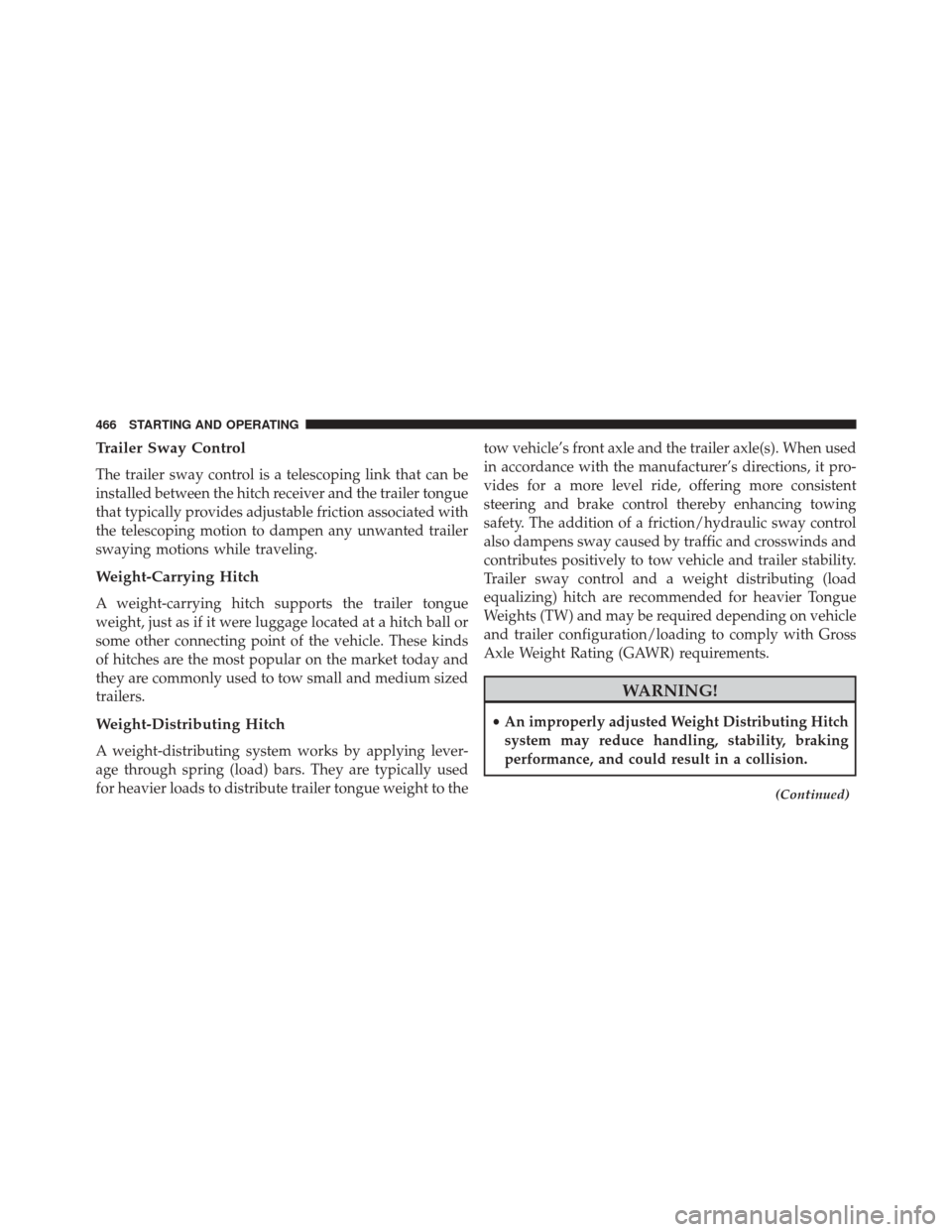
Trailer Sway Control
The trailer sway control is a telescoping link that can be
installed between the hitch receiver and the trailer tongue
that typically provides adjustable friction associated with
the telescoping motion to dampen any unwanted trailer
swaying motions while traveling.
Weight-Carrying Hitch
A weight-carrying hitch supports the trailer tongue
weight, just as if it were luggage located at a hitch ball or
some other connecting point of the vehicle. These kinds
of hitches are the most popular on the market today and
they are commonly used to tow small and medium sized
trailers.
Weight-Distributing Hitch
A weight-distributing system works by applying lever-
age through spring (load) bars. They are typically used
for heavier loads to distribute trailer tongue weight to thetow vehicle’s front axle and the trailer axle(s). When used
in accordance with the manufacturer’s directions, it pro-
vides for a more level ride, offering more consistent
steering and brake control thereby enhancing towing
safety. The addition of a friction/hydraulic sway control
also dampens sway caused by traffic and crosswinds and
contributes positively to tow vehicle and trailer stability.
Trailer sway control and a weight distributing (load
equalizing) hitch are recommended for heavier Tongue
Weights (TW) and may be required depending on vehicle
and trailer configuration/loading to comply with Gross
Axle Weight Rating (GAWR) requirements.
WARNING!
•
An improperly adjusted Weight Distributing Hitch
system may reduce handling, stability, braking
performance, and could result in a collision.
(Continued)
466 STARTING AND OPERATING
Page 469 of 620

WARNING!(Continued)
•Weight Distributing Systems may not be compat-
ible with Surge Brake Couplers. Consult with your
hitch and trailer manufacturer or a reputable Rec-
reational Vehicle dealer for additional information.
Trailer Hitch Classification
The following chart provides the industry standard for
the maximum trailer weight a given trailer hitch class can
tow and should be used to assist you in selecting the
correct trailer hitch for your intended towing condition.
Trailer Hitch Classification Definitions
Class Max. Trailer Hitch Industry Standards
Class I - Light Duty 2,000 lbs (907 kg)
Class II - Medium Duty 3,500 lbs (1 587 kg)
Class III - Heavy Duty 5,000 lbs (2 267 kg)
Class IV - Extra Heavy Duty 10,000 lbs (4 535 kg)
Refer to the “Trailer Towing Weights (Maximum Trailer Weight Ratings)” chart for the Maximum Gross Trailer
Weight (GTW) towable for your given drivetrain.
All trailer hitches should be professionally installed on your vehicle.5
STARTING AND OPERATING 467
Page 470 of 620
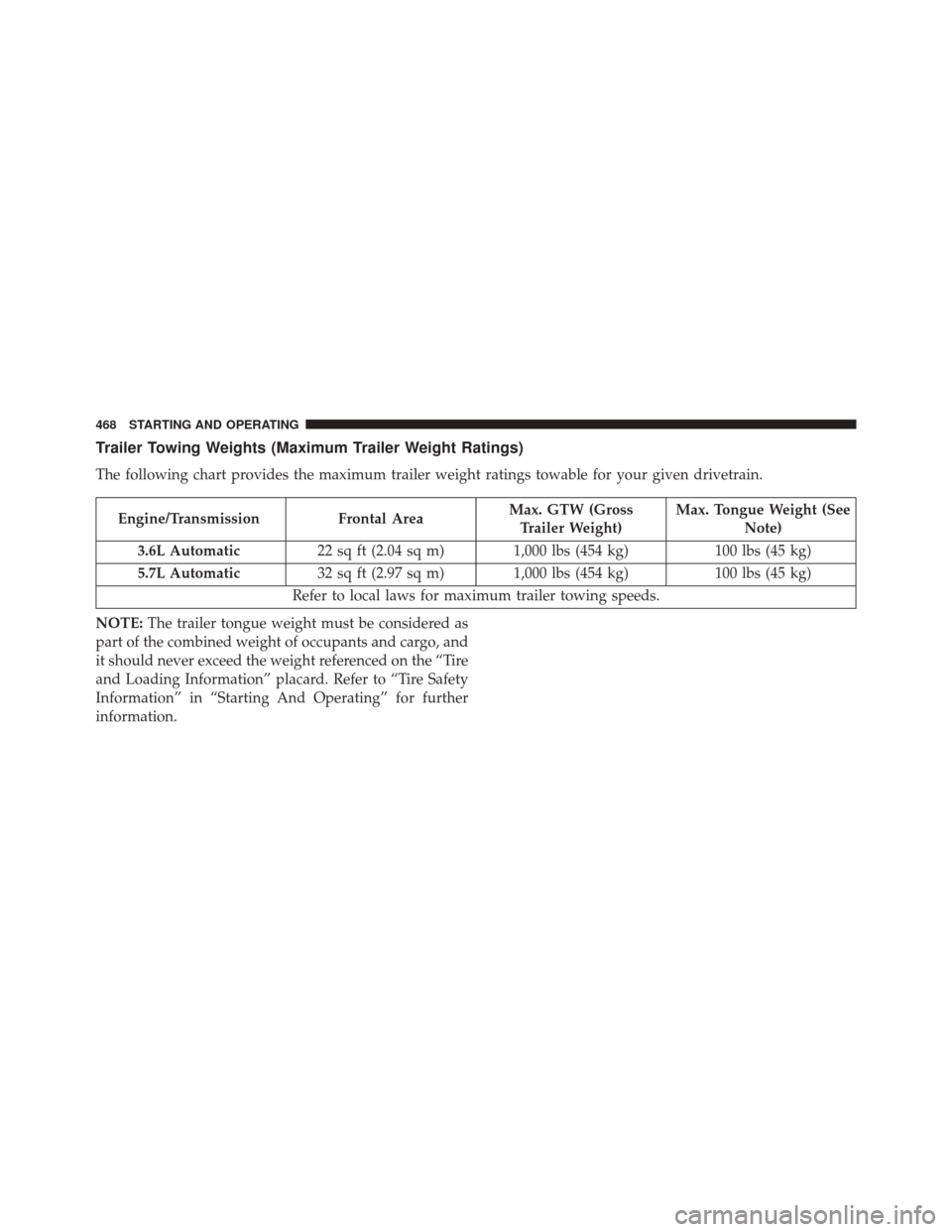
Trailer Towing Weights (Maximum Trailer Weight Ratings)
The following chart provides the maximum trailer weight ratings towable for your given drivetrain.
Engine/TransmissionFrontal AreaMax. GTW (Gross
Trailer Weight) Max. Tongue Weight (See
Note)
3.6L Automatic 22 sq ft (2.04 sq m) 1,000 lbs (454 kg) 100 lbs (45 kg)
5.7L Automatic 32 sq ft (2.97 sq m) 1,000 lbs (454 kg) 100 lbs (45 kg)
Refer to local laws for maximum trailer towing speeds.
NOTE: The trailer tongue weight must be considered as
part of the combined weight of occupants and cargo, and
it should never exceed the weight referenced on the “Tire
and Loading Information” placard. Refer to “Tire Safety
Information” in “Starting And Operating” for further
information.
468 STARTING AND OPERATING
Page 471 of 620
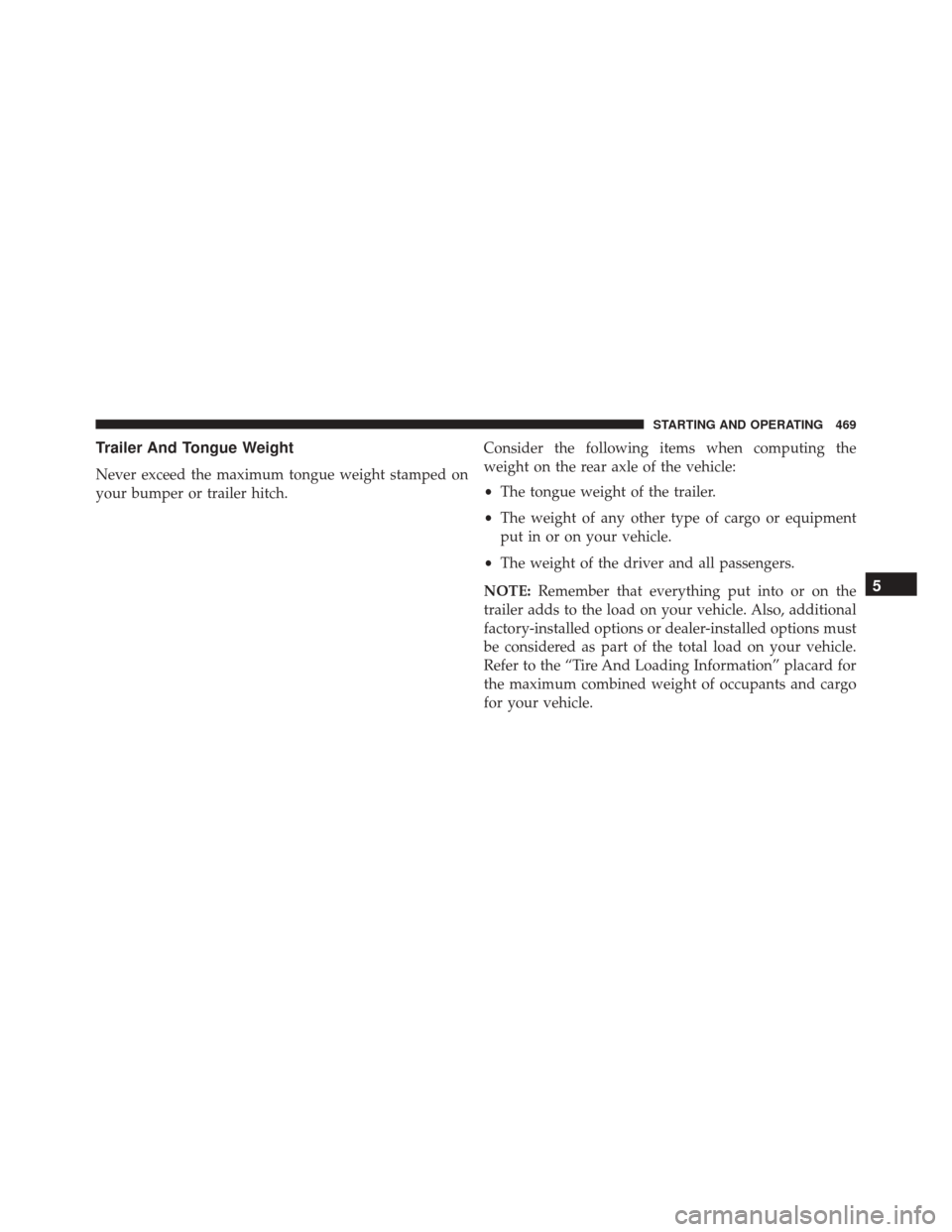
Trailer And Tongue Weight
Never exceed the maximum tongue weight stamped on
your bumper or trailer hitch.Consider the following items when computing the
weight on the rear axle of the vehicle:
•
The tongue weight of the trailer.
• The weight of any other type of cargo or equipment
put in or on your vehicle.
• The weight of the driver and all passengers.
NOTE: Remember that everything put into or on the
trailer adds to the load on your vehicle. Also, additional
factory-installed options or dealer-installed options must
be considered as part of the total load on your vehicle.
Refer to the “Tire And Loading Information” placard for
the maximum combined weight of occupants and cargo
for your vehicle.
5
STARTING AND OPERATING 469
Page 473 of 620
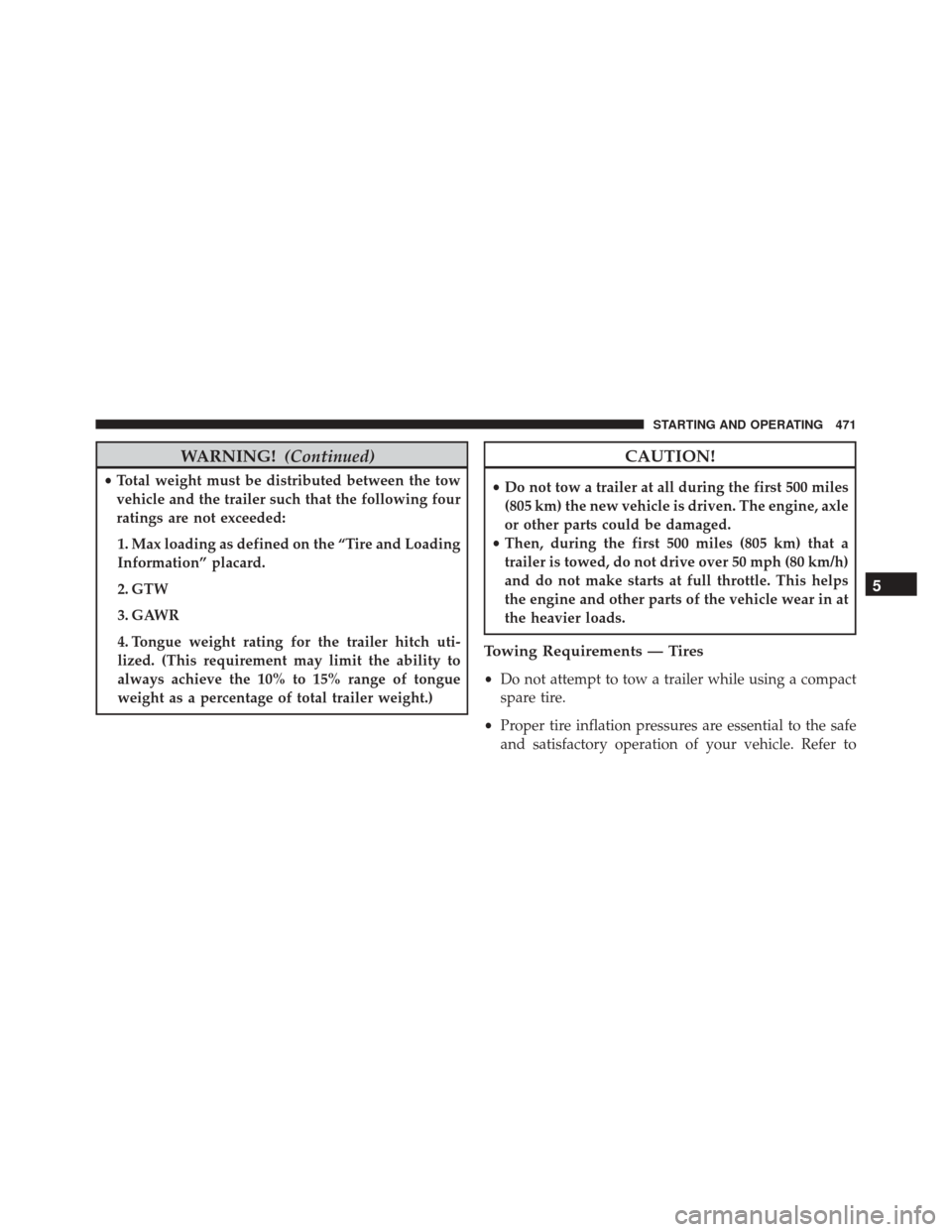
WARNING!(Continued)
•Total weight must be distributed between the tow
vehicle and the trailer such that the following four
ratings are not exceeded:
1. Max loading as defined on the “Tire and Loading
Information” placard.
2. GTW
3. GAWR
4. Tongue weight rating for the trailer hitch uti-
lized. (This requirement may limit the ability to
always achieve the 10% to 15% range of tongue
weight as a percentage of total trailer weight.)
CAUTION!
• Do not tow a trailer at all during the first 500 miles
(805 km) the new vehicle is driven. The engine, axle
or other parts could be damaged.
• Then, during the first 500 miles (805 km) that a
trailer is towed, do not drive over 50 mph (80 km/h)
and do not make starts at full throttle. This helps
the engine and other parts of the vehicle wear in at
the heavier loads.
Towing Requirements — Tires
• Do not attempt to tow a trailer while using a compact
spare tire.
• Proper tire inflation pressures are essential to the safe
and satisfactory operation of your vehicle. Refer to
5
STARTING AND OPERATING 471
Page 604 of 620

Fuses................................. .546
Garage Door Opener (HomeLink) ..........234, 241
Gasoline, Clean Air ....................... .451
Gasoline (Fuel) .......................... .450
Gasoline, Reformulated .....................451
Gauges Fuel ................................ .291
Gear Ranges ............................ .385
Glass Cleaning .......................... .544
Gross Axle Weight Rating ................462, 465
Gross Vehicle Weight Rating ..............462, 464
GVWR ................................ .462
Hazard Driving Through Flowing, Rising, Or Shallow Stand-
ing Water ............................ .396
Hazard Warning Flasher ....................478
Headlights ............................. .563Automatic
........................... .153
Cleaning ............................ .544
Delay ............................... .153
High Beam/Low Beam Select Switch .........159
Lights On Reminder .....................156
On With Wipers .....................153, 166
Passing ............................. .159
Switch .............................. .152
Time Delay ........................... .153
Washers ............................. .525
Headlight Washers ....................... .525
Head Restraints ...................... .141, 143
Head Rests ......................... .141, 143
Heated Mirrors .......................... .122
Heated Seats ............................ .137
Heater, Engine Block ...................... .381
High Beam/Low Beam Select (Dimmer) Switch . . . .159
Hill Start Assist .......................... .407
602 INDEX
Page 615 of 620
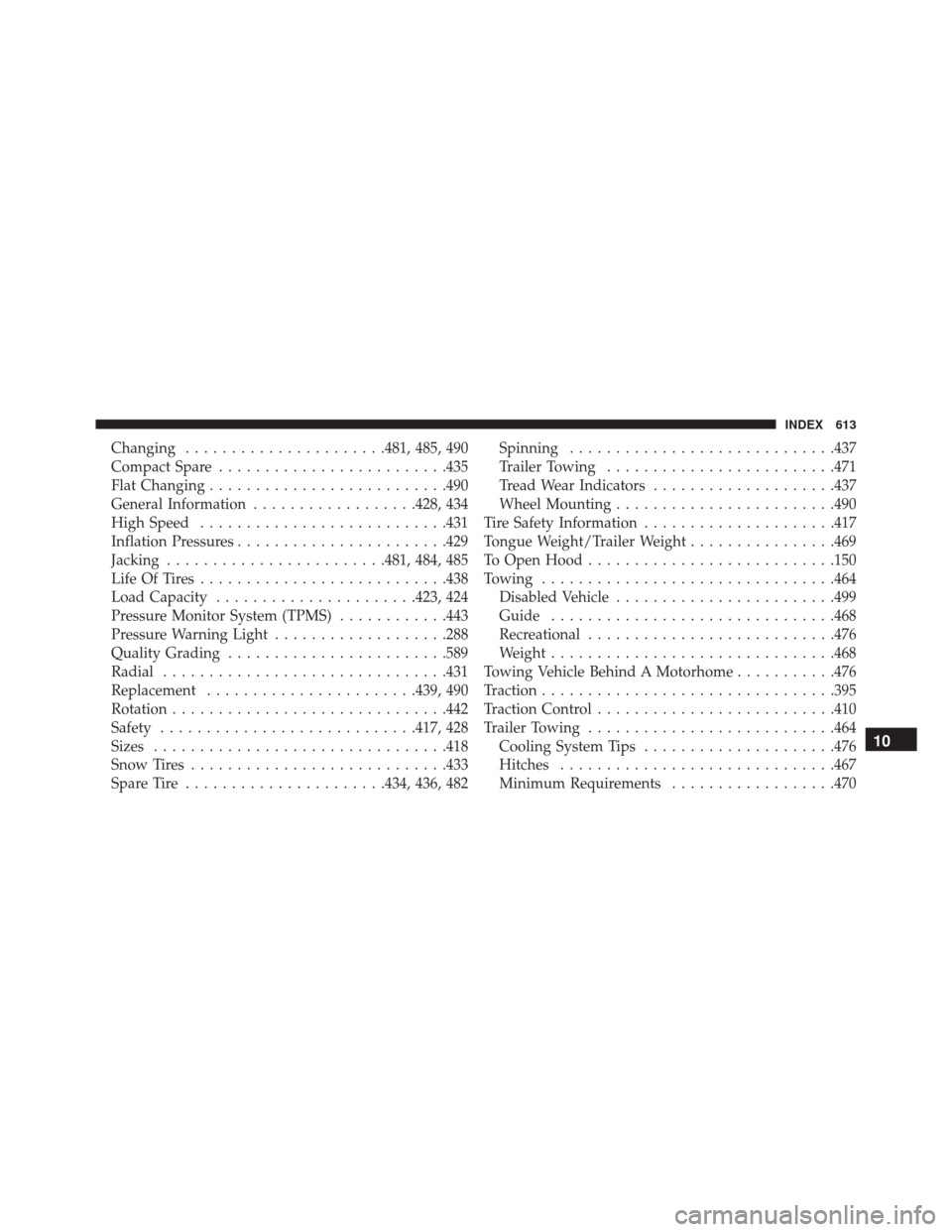
Changing..................... .481, 485, 490
Compact Spare ........................ .435
Flat Changing ......................... .490
General Information ..................428, 434
High Speed .......................... .431
Inflation Pressures ...................... .429
Jacking ....................... .481, 484, 485
Life Of Tires .......................... .438
Load Capacity ..................... .423, 424
Pressure Monitor System (TPMS) ............443
Pressure Warning Light ...................288
Quality Grading ....................... .589
Radial .............................. .431
Replacement ...................... .439, 490
Rotation ............................. .442
Safety ........................... .417, 428
Sizes ............................... .418
Snow Tires ........................... .433
Spare Tire ..................... .434, 436, 482Spinning
............................ .437
Trailer Towing ........................ .471
Tread Wear Indicators ....................437
Wheel Mounting ....................... .490
Tire Safety Information .....................417
Tongue Weight/Trailer Weight ................469
To Open Hood .......................... .150
Towing ............................... .464
Disabled Vehicle ....................... .499
Guide .............................. .468
Recreational .......................... .476
Weight .............................. .468
Towing Vehicle Behind A Motorhome ...........476
Traction ............................... .395
Traction Control ......................... .410
T
railer Towing .......................... .464
Cooling System Tips .....................476
Hitches ............................. .467
Minimum Requirements ..................470
10
INDEX 613
Page 616 of 620
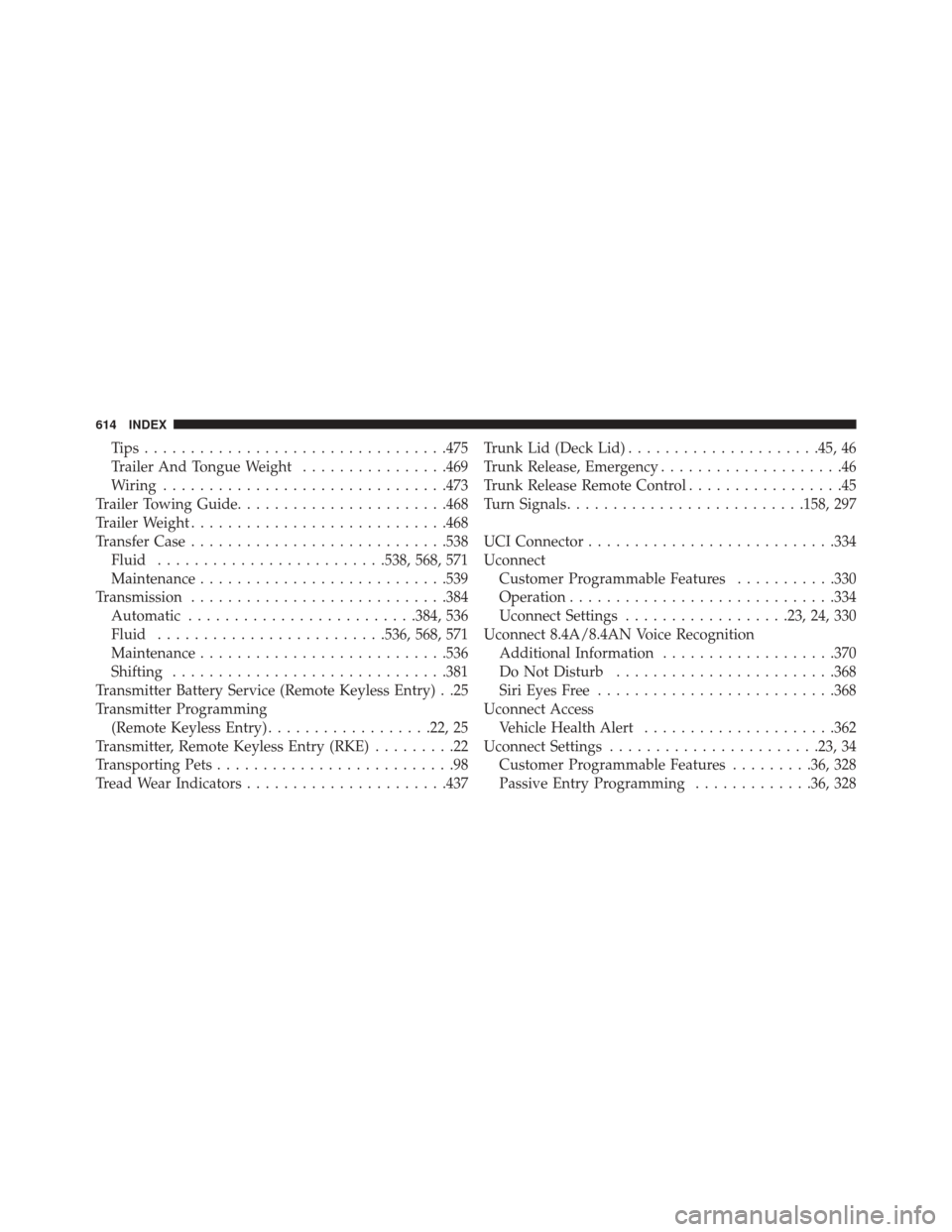
Tips.................................475
Trailer And Tongue Weight ................469
Wiring .............................. .473
Trailer Towing Guide ...................... .468
Trailer Weight ........................... .468
Transfer Case ........................... .538
Fluid ........................ .538, 568, 571
Maintenance .......................... .539
Transmission ........................... .384
Automatic ........................ .384, 536
Fluid ........................ .536, 568, 571
Maintenance .......................... .536
Shifting ............................. .381
Transmitter Battery Service (Remote Keyless Entry) . .25
Transmitter Programming (Remote Keyless Entry) ..................22, 25
Transmitter, Remote Keyless Entry (RKE) .........22
Transporting Pets ..........................98
Tread Wear Indicators ..................... .437Trunk Lid (Deck Lid)
.....................45, 46
Trunk Release, Emergency ....................46
Trunk Release Remote Control .................45
Turn Signals ......................... .158, 297
UCI Connector .......................... .334
Uconnect Customer Programmable Features ...........330
Operation ............................ .334
Uconnect Settings ..................23, 24, 330
Uconnect 8.4A/8.4AN Voice Recognition Additional Information ...................370
Do Not Disturb ....................... .368
Siri Eyes Free ......................... .368
Uconnect Access Vehicle Health Alert .....................362
Uconnect Settings ...................... .23, 34
Customer Programmable Features .........36, 328
Passive Entry Programming .............36, 328
614 INDEX